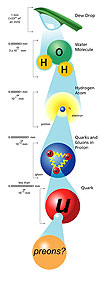And so, ad infinitum: Smallest of the small
 |
|
Scientists are searching for particles smaller than the familiar ones of the Standard Model.
|
Big fleas have little fleas,
Upon their backs to bite 'em,
And little fleas have lesser fleas,
and so, ad infinitum. —Augustus De Morgan
Suppose you were the size of the universe - you would see a bunch of luminous, point-like dots surrounding you. If you shrank, you'd identify these points as galaxies, each with a rich structure and each filled with a new bunch of point-like dots. As you shrink more, you'd see that these new dots were not points, but stars.
If you pressed the supershrink button on your shrink ray, you'd zoom down through the size of humans, through cells, molecules, atoms, atomic nuclei, protons and neutrons and finally down to the size of the quarks and leptons that constitute the knowledge frontier of the super small. Over the past hundred years or so, a series of objects like atoms were thought to be the smallest building block of matter, only to have subsequent research show that we were wrong.
The Standard Model exemplifies the micro world of particle physics. Two classes of particles, called quarks and leptons, are thought to be the smallest building blocks of the universe. They have no size and contain nothing in them, but, if mixed correctly, they can build atoms, us, the entire universe.
After about a century of progressively finding something smaller than what we thought was the smallest, why should anyone think that these quarks and leptons are the final word? The answer is complex.
At the experimental level, the answer is unequivocal. There is precisely zero evidence that quarks and leptons have any size at all. Physicists at Fermilab's Tevatron and CERN's LEP and LHC colliders have set a limit on the size of quarks and leptons, which is that they must be smaller than about 0.001 times the size of a proton. The sensitivity of the detectors would let us see quarks and leptons if they were larger than that, so we know they must be smaller.
On the flip side of the argument, the Standard Model offers an explanation for the possibility that quarks and leptons have an internal structure. Ordinary matter is made of up and down quarks (found inside protons and neutrons) and electrons. The charm and top quarks seem to be heavier carbon copies of the up quark. Similarly, the strange and bottom quarks are clones of the down quark, while the muon and tau lepton are heavier cousins of the electron. This repetitive structure is reminiscent of the periodic table of chemical elements, in which the columns of chemically similar elements were the first signs that the atoms weren't point-like. Maybe the heavier copies of the quarks and leptons signal the next level in the subatomic onion.
Theoretical physicists are aware of these possibilities and have written hundreds of papers describing hypothetical particles as the building blocks of quarks and leptons. The names suggested for these proposed particles include subquarks, maons, alphons, quinks, quips, rishons, tweedles, helons, haplons and Y-particles. The most common, generic term physicists use is preons.
The LHC and Fermilab's Intensity Frontier experimental program are ideal methods for looking for direct evidence for preons. The first approach is brute force – we smash the quarks and leptons together to see how they behave. If the collisions act point-like, the quarks and leptons might have zero size, or at least be smaller than we can measure.. The second approach looks for very rare processes, including muons decaying into electrons and photons or to measure the spin of a muon (technically the magnetic moment), to see if they have non-zero size.
The search for the ultimate building blocks of matter is an old quest, begun anew with each advance in accelerator and detectors. The recent and near future improvements in particle physics instrumentation makes this an exciting time for those of us searching for the smallest of the small.
Want a phrase defined? Have a question? Email Fermilab Today.
—Don Lincoln
|